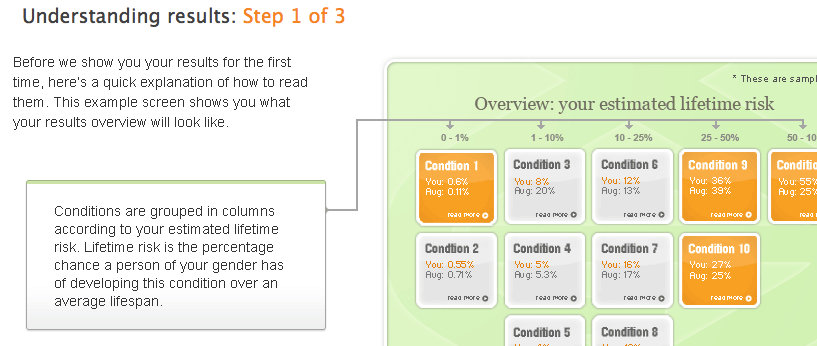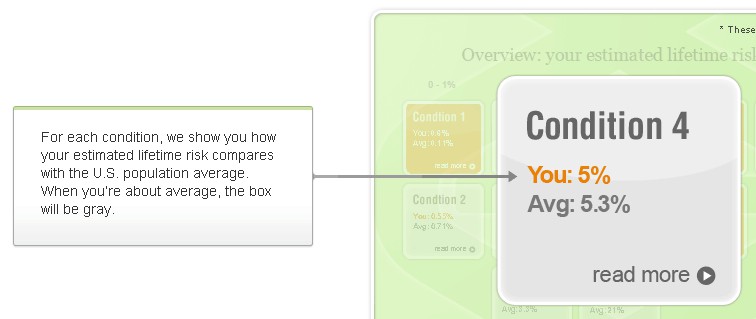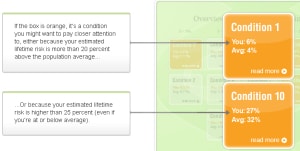
At the beginning of 2009, I announced that I would be participating in the Scripps Research study on the impact of knowledge of one’s genetic disposition to behavior. In other words, does advanced knowledge of genetic disposition change behaviors of consumers to mitigate that disposition? This is a multi-partner research effort that includes Scripps Research, Navigenics, Affymetrix and Microsoft HealthVault.
Purpose of my participating is to first gain a better understanding of such direct to consumer (DTC) genetic testing services and secondly, see how such information may be used in the future within the context of a Personal Health Account (import SNP data into HealthVault).
The Experience:
Thankfully, I was not in a rush to get the results as it took Navigenics nearly three months to turn this around, though Navigenics did inform me up-front that it would take some time as they would release results to all participants at the same time. But alas, I finally received an email with a link to the site wherein I was dutifully asked to securely sign-in. Note: security password requirements are quite strict.
After logging in, Navigenics provides a thorough educational review of how the data will be presented, which consists of gray and orange boxes. These boxes give the estimated lifetime risk for each of the 22 conditions (ranging from Abdominal Aneurysm to Stomach Cancer) that Navigenics currently tests for. They add additional tests to their service as research dictates (new genetic markers identified and reported upon in peer-reviewed research papers).
Having a gray box for a given genetic disposition is good as it signifies a relatively low genetic risk to a specific disease.
But those orange boxes are the ones you really need to look out for as according to research studies that Navigenics researchers deem worthy, your genetic make-up signifies an overall risk that is either higher than 25% or your risk is 20% or more higher than the rest of the population.
Prior to reviewing results, Navigenics makes many statements to the effect that don’t go off and do something drastic based on your results. They also provide you the opportunity to selectively choose which results to review.
When reviewing results, Navigenics does a very good job of providing information about a specific disease, what the results mean, how they were obtained and the relative ratio of genetic disposition and environmental risk factors in contracting the disease. And for those that are particularly inclined to the science behind the findings, links to specific research papers on a given gene and disease association. Quite an impressive amount of information that Navigenics provides to the consumer. In addition to this online information, Navigenics offers genetic counseling, via phone, to go over the results and their implications. This is particularly helpful for those whoe results may point to an extremely high risk of contracting a fatal, yet treatable disease.
Always looking for the biggest bang for the buck, I selected all 22 tests/conditions.
Now I am not going to share the specifics of those tests but what I will share is my disbelief and deep concern about such DTC genetic testing services.
Prior to going through with this exercise, I spoke to Prof. Rudolph Tanzi of Harvard and author of Decoding Darkness who just happens to be one of the researchers responsible for finding the first Alzheimer’s gene. Prof. Tanzi was quite frank basically stating that such services are simply a modern form of snake-oil salesmen. His primary argument against such services is that the science is simply not mature enough to make any predictions as to future genetic risk.
The problem is that for every gene that may put you at risk for a given disease, you may also have a countervailing gene that has yet to be discovered that cancels out that bad gene. Thing is, today we know so little about the interactions between genes – we are in the “stone age” of genetics. I also was not that comforted to learn that in all those gray and orange boxes for which you were compared against a broader population, that population consists of a meager 60 Americans of European descent who have participated in the HapMap Project. Hardly representative, so I’m not placing too much credence to any comparisons to the population in my results.
Digging deeper into one specific disease, Diabetes Type-II, I showed a high risk with 15 of 22 markers for this disease found in my genetic code. Nervous? Concerned? Rushing off to make an appointment with a doctor? Combing the Internet for more information on this disease? No, I have done none of these things for contrary to the results, I do not believe I am at risk.
Why this laissez faire attitude?
I know of no blood relatives on either side of the family that have ever contracted diabetes, period! It simply does not exist in my family-tree so I can only conclude that there are quite a few genes in my genetic make-up that have yet to be discovered which are firmly putting the brakes on those 15 markers that, according to research, put me at risk.
Which leads me to wonder: If the Navigenics test for diabetes delivers such poor results (Note: Navigenics tests for 22 diabetes markers, a significantly large number of markers compared to other disease tested for, e.g., heart disease has only 4 markers), are the other diseases tested for even more suspect? Willing to place a very big bet that the answer is yes.
Therein is the risk for the general population who may embark on such a genetic adventure. After receiving their results, might a consumer take actions unwarranted or worse, put them at even greater risk. We are not in just the “Stone Age” of genetic research, we are at least that far back, if not greater in the knowledge among the general public, including physicians, on what genetic tests results truly mean. We are simply not there as a community to make any drastic decisions at all based solely on genetic test data. That’s not to say we can’t go forth and simply live healthier lives: eat well, sleep well and exercise, advice often given by Navigenics to control environmental risk factors.
But as pointed out in the previous post, maybe we need to think differently about what might be the potential value of performing such a genetic tests such as personalized medicine, clinical trials recruitment, etc. To enable such activities, the ability to export one’s genetic information into their personal health account is necessary. Unfortuantely, despite the partnership with HealthVault, Navigenics did not provide me an option to upload my SNP data to my HealthVault account. Hopefully, this is forthcoming and when it is, I’ll report on that experience as well.
For another perspective, encourage you to read Berci’s experience with Navigenics.







Hey John … just a quick follow-up. the Navi folks are still finishing their HealthVault upload — but it will be done within the next few weeks.
—S
John,
Excellent review and very valid points. I’ll link to you post in my Twitter community and will include it in the next Gene Genie blog carnival edition, if you don’t mind.
Thank you for the mention!
Berci
It is not conclusive, as you suggest, that all genes that convey susceptibility to a given disease have been identified. In fact, the domain is very much in its infancy. However, you can increase the power of the existing genomic information by combining those data with your other personal health data, as was suggested by Barbara Prainsack and Jenny Reardon in their commentary in Nature (see http://www.nature.com/nature/journal/v456/n7218/full/456034a.html).
Thus, I believe it was irresponsible for the ‘pioneers’ consisting of the first 10 members of the Personal Genome Project to post their genomic data along with their own personal health information (see http://www.personalgenomes.org/pgp10.html).
It not only sets a bad precendent, but it could also harm their offspring when new disease genes are identified, placing not only themselves but also their offspring at risk of not obtaining medical insurance and other coverage (look at the actions of the Medical Information Bureau (MIB), that has been collecting personal health information for years. The MIB is an organization established by the insurance industry (as they describe it, “similar to a credit-reporting agency”) that collects data on individuals
from various healthcare insurance claims. The MIB then distributes this information, correct or not, to the health and life insurance companies as requested).